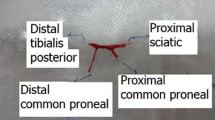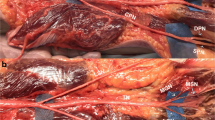Abstract
Background
Delayed reinnervation of denervated motor neuron has irreversible consequences. We introduced distal motor to distal sensory anastomosis (DDSA) as a practical, time-saving method to protect injured motor neurons and its target tissues.
Methods
Two experimental groups of Wistar rats were studied. In DDSA group, the distal end of the tibial sensory nerve of the left leg was anastomosed to the distal common peroneal nerve. The same nerves were dissected without anastomosis in the control group. Four months later, visual functional assessment of sciatic nerves was performed, and histological structures of the nerves and muscles and ultra-structure of nerves were evaluated.
Results
Significant enhancement was seen in intermediate toe spread factor in DDSA group (P < 0.05), but toe spread factor and subsequently sciatic statistic index demonstrated no significant improvement. The surgical procedures resulted in an ipsilateral rehabilitation in DDSA group with statistically significant (P < 0.05) improvement in muscle weight and myelinated axon count. Light and electron microscopy evaluations of the histological specimen showed obvious prevention of nerve and muscle tissues degeneration following anastomosis.
Conclusions
Overall, DDSA showed a peripheral nerve could repair, survive, and protect target tissues from degeneration without connection to their cell bodies and central nervous system. Some possible explanations for these positive results could be the restorative role of electrochemical signaling directly from the skin sensory nerve receptors and stimulation of Schwann cell to convert to its regenerative phenotype.
Level of Evidence: Not ratable.






Similar content being viewed by others

References
Al-Majed AA, Neumann CM, Brushart TM, Gordon T (2000) Brief electrical stimulation promotes the speed and accuracy of motor axonal regeneration. J Neurosci 20:2602–2608
Grinsell D, Keating CP (2014) Peripheral nerve reconstruction after injury: a review of clinical and experimental therapies. Biomed Res Int 2014:698256
Finkelstein DI, Dooley PC, Luff AR (1993) Recovery of muscle after different periods of denervation and treatments. Muscle Nerve 16:769–777
Fu SY, Gordon T (1995) Contributing factors to poor functional recovery after delayed nerve repair: prolonged denervation. J Neurosci 15:3886–3895
Nghiem BT, Sando IC, Hu Y, Urbanchek MG, Cederna PS (2015) Sensory protection to enhance functional recovery following proximal nerve injuries: current trends. Plast Aesthet Res 2:202–207
Hynes NM, Bain JR, Thoma A, Veltri K, Maguire JA (1997) Preservation of denervated muscle by sensory protection in rats. J Reconstr Microsurg 13:337–343
Bain JR, Veltri KL, Chamberlain D, Fahnestock M (2001) Improved functional recovery of denervated skeletal muscle after temporary sensory nerve innervation. Neuroscience 103:503–510
Li QT, Zhang PX, Yin XF et al (2013) Functional recovery of denervated skeletal muscle with sensory or mixed nerve protection: a pilot study. PLoS One 8:e79746
Zuijdendorp HM, Tra WMW, van Neck JW, Mollis L, Coert JH (2010) Delay of denervation atrophy by sensory protection in an end-to-side neurorrhaphy model: a pilot study. J Plast Reconstr Aesthet Surg 63:1949–1952
Shea JE, Garlick JW, Salama ME, Mendenhall SD, Moran LA, Agarwal JP (2014) Side-to-side nerve bridges reduce muscle atrophy after peripheral nerve injury in a rodent model. J Surg Res 187:350–358
Wang H, Gu Y, Xu J, Shen L, Li J (2001) Comparative study of different surgical procedures using sensory nerves or neurons for delaying atrophy of denervated skeletal muscle. J Hand Surg Am 26:326–331
Salvini TF, Durigan JL, Peviani SM, Russo TL (2012) Effects of electrical stimulation and stretching on the adaptation of denervated skeletal muscle: implications for physical therapy. Rev Bras Fisioter 16:175–183
Faroni A, Mobasseri SA, Kingham PJ, Reid AJ (2015) Peripheral nerve regeneration: experimental strategies and future perspectives. Adv Drug Deliv Rev 82–83:160–167
Moimas S, Novati F, Ronchi G et al (2013) Effect of vascular endothelial growth factor gene therapy on post-traumatic peripheral nerve regeneration and denervation-related muscle atrophy. Gene Ther 20:1014–1021
Yohn DC, Miles GB, Rafuse VF, Brownstone RM (2008) Transplanted mouse embryonic stem-cell-derived motoneurons form functional motor units and reduce muscle atrophy. J Neurosci 28:12409–12418
Bervar M (2000) Video analysis of standing—an alternative footprint analysis to assess functional loss following injury to the rat sciatic nerve. J Neurosci Methods 102:109–116
Hosseinian MA, Gharibi Loron A, Nemati B, Khandaghy M (2015) Comparison of a distal end-to-side neurorrhaphy with a proximal-distal end-to-side neurorrhaphy: in a rat model. Eur J Orthop Surg Traumatol 25:1261–1264
Hart AM, Terenghi G, Wiberg M (2008) Neuronal death after peripheral nerve injury and experimental strategies for neuroprotection. Neurol Res 30:999–1011
Gordon T, Tyreman N, Raji MA (2011) The basis for diminished functional recovery after delayed peripheral nerve repair. J Neurosci 31:5325–5334
Berdan RC, Easaw JC, Wang R (1993) Alterations in membrane potential after axotomy at different distances from the soma of an identified neuron and the effect of depolarization on neurite outgrowth and calcium channel expression. J Neurophysiol 69:151–164
Papakonstantinou KC, Kamin E, Terzis JK (2002) Muscle preservation by prolonged sensory protection. J Reconstr Microsurg 18:173–182
Zochodne DW (2012) The challenges and beauty of peripheral nerve regrowth. J Peripher Nerv Syst 17:1–18
Makwana M, Raivich G (2005) Molecular mechanisms in successful peripheral regeneration. FEBS J 272:2628–2638
Beck-Broichsitter BE, Becker ST, Lamia A, Fregnan F, Geuna S, Sinis N (2014) Sensoric protection after median nerve injury: babysitter-procedure prevents muscular atrophy and improves neuronal recovery. Biomed Res Int 2014:7
Acknowledgements
We would like to express our sincere gratitude to Mr. Pouyan Shaker for his help in editing the final draft of this article.
Author information
Authors and Affiliations
Corresponding author
Ethics declarations
Funding
This study was funded by Shahid Beheshti University of Medical Sciences (no grant number).
Conflict of interest
Mohammad Ali Hosseinian, Sadegh Shirian, Ali Gharibi Loron, Abdul Ali Ebrahimy, Gholam Hossein Hayatolah declare that they have no conflict of interest.
Ethical approval
All procedures performed in studies involving animals were in accordance with the ethical standards of the institutional animal ethics committee of the Shahid Beheshti University of Medical Sciences.
Rights and permissions
About this article
Cite this article
Hosseinian, M.A., Shirian, S., Loron, A.G. et al. Distal sensory to distal motor nerve anastomosis can protect lower extremity muscle atrophy in a murine model. Eur J Plast Surg 41, 9–14 (2018). https://doi.org/10.1007/s00238-017-1313-z
Received:
Accepted:
Published:
Issue Date:
DOI: https://doi.org/10.1007/s00238-017-1313-z



